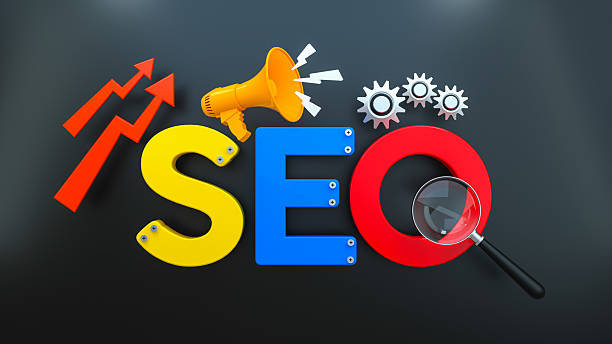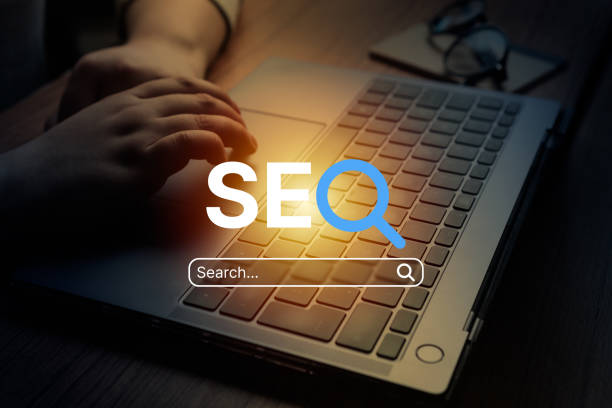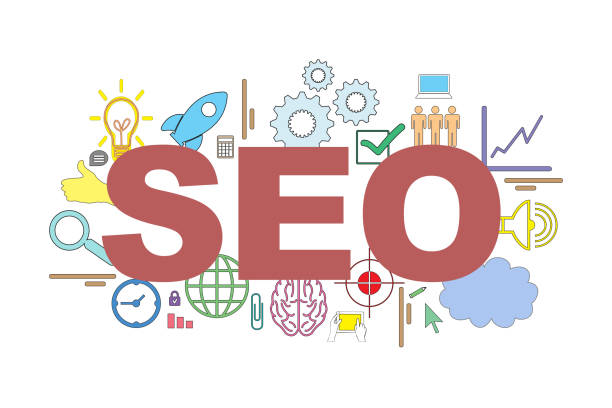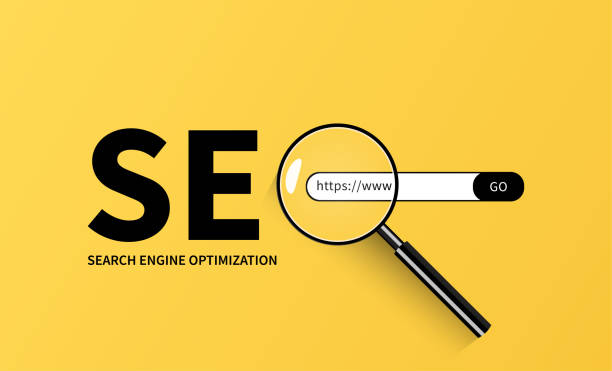What is Internal SEO and Why is it Important?
Internal SEO, also known as #On_Page_SEO, is a set of actions you take within your website to improve your site’s ranking in Google search results and other search engines.
These actions include optimizing content, site structure, HTML tags, and other factors related to user experience (UX).
Internal SEO is important because it helps search engines better understand your site’s content and show it to users who are looking for related information.
In other words, internal SEO creates a bridge between your website and search engines, helping you attract more organic (free) traffic.
Doing internal SEO correctly can lead to increased site ranking, increased visits, improved conversion rates, and ultimately increased revenue.
In fact, internal SEO complements external SEO.
While external SEO focuses on actions taken outside of your website (such as link building), internal SEO focuses on improving the elements within the website.
Both of these aspects are essential for a successful SEO strategy.
For example, you can produce the best content in the world, but if your site is not optimized for internal SEO, you are unlikely to be seen in search results.
Therefore, investing in internal SEO is a smart investment for any business looking to grow online.
To start with internal SEO, you should first conduct keyword research.
Don’t have a company website yet and are missing out on online opportunities? With professional corporate website design by Rasaweb,
✅ Double your business credibility
✅ Attract new customers
⚡ Free consultation for your company website!
Keyword Research – The Foundation of Internal SEO
Keyword research is the process of identifying the words and phrases that your target audience enters into search engines.
These words and phrases should be relevant to your business, products, and services.
Keyword research helps you understand exactly what your audience is looking for and how you can tailor your content accordingly.
There are various tools for keyword research, including Google Keyword Planner, Ahrefs, SEMrush, and Moz Keyword Explorer.
These tools help you examine search volume, competition, and other important keyword metrics.
Click here to preview your posts with PRO themes ››
After finding the right keywords, you should strategically use them in your content.
This includes using keywords in titles, meta descriptions, body text, and image tags.
However, it is important to avoid overusing your keywords, as this can lead to your site being penalized by search engines.
Instead, try to incorporate your keywords naturally into your content and create valuable and relevant content for your audience.
Using keywords correctly has a significant impact on your site’s internal SEO.
Content Optimization – The King of Internal SEO
Content is king! This cliché still holds true in the world of SEO.
High-quality, engaging, and relevant content is essential for success in internal SEO.
Your content should answer your audience’s questions and needs, and encourage them to stay longer on your site and engage with your content.
When creating content, pay attention to the following
- Value: Your content should be valuable and useful.
- Originality: Avoid copying other people’s content.
- Relevance: Your content should be relevant to your keywords.
- Readability: Your content should be readable and understandable.
In addition, it’s important to update your content regularly and create fresh, new content.
Search engines reward sites that publish new and relevant content.
Content SEO is very important for increasing internal SEO ranking.
| Content Element | Description | Key Tips |
|---|---|---|
| Page Title (Title Tag) | The title of the page that appears in search results. | Include the main keyword, be attractive and concise. |
| Meta Description | A summary of the page’s content that appears below the title in search results. | Be engaging, include relevant keywords, and have a call to action. |
| Subheadings (Headings) | Main and subheadings to organize content. | Use keywords in subheadings, logical structure, and high readability. |
| Body Text | The main content of the page. | High-quality, relevant content, natural use of keywords, and high readability. |
HTML Tag Optimization – A Common Language with Search Engines
HTML tags help search engines understand the structure and content of your page.
Optimizing HTML tags is one of the most important aspects of internal SEO.
Some of the most important HTML tags that need to be optimized include
- Title Tag: Your page’s title that appears in search results.
- Meta Description Tag: A summary of your page’s content that appears below the title in search results.
- Heading Tags: H1 to H6 tags to organize your content.
- Image Alt Tag: Alternative text for your images.
When optimizing HTML tags, make sure you use relevant keywords and provide accurate and engaging information.
For example, your title tag should include your primary keyword and provide an accurate and engaging description of the page’s content.
Optimizing these tags helps your site’s internal SEO.
Does your company’s website perform as well as your brand deserves? In today’s competitive world, your website is your most important online tool. Rasaweb, a specialist in professional company website design, helps you to:
✅ Attract the credibility and trust of customers
✅ Turn website visitors into customers
⚡ Get a free consultation!
URL Structure – Easy Navigation for Users and Search Engines
Your website’s URL structure plays an important role in internal SEO and user experience.
Your URLs should be short, descriptive, and include relevant keywords.
A good URL structure helps users and search engines easily navigate your site and find the content they’re looking for.
Avoid using long, complex, and incomprehensible URLs.
For example, instead of using the following URL
www.example.com/page?id=12345
Use the following URL
www.example.com/blog/seo-internal
The second URL is clearer, more descriptive, and includes the keyword “internal SEO”.
Internal Linking – A Network of Connections
Internal linking refers to the process of linking from one page on your site to another.
Internal linking helps search engines understand your site’s structure and determine the importance of different pages.
In addition, internal linking helps users easily navigate your site and find relevant content.
When linking between pages, make sure you use relevant anchor text.
Anchor text is the text that is linked to another page.
For example, if you are linking from the “Internal SEO Guide” page to the “Keyword Research” page, your anchor text could be “keyword research”.
This helps search engines understand what the destination page is about.
An internal linking strategy is very important for internal SEO.
Site Speed – Smooth and Fast User Experience
Site speed is an important ranking factor in Google.
Users expect websites to load quickly.
If your site is slow, users are likely to leave your site and go to your competitors.
In addition, Google rewards sites that have high speeds.
To improve your site speed, you can take various actions, including
- Optimizing images
- Compressing files
- Using a CDN
- Optimizing code
- Choosing a quality hosting provider
You can use tools like Google PageSpeed Insights and GTmetrix to check your site speed and identify potential problems.
Site speed has a significant impact on internal SEO.
| Factor | Importance | Solutions |
|---|---|---|
| Image Optimization | High | Reduce image size without losing quality, use modern formats (WebP). |
| File Compression | High | Compress CSS, JS, and HTML files to reduce data transfer size. |
| Using a CDN | Medium | Using a Content Delivery Network to load files faster from the nearest server. |
| Code Optimization | Medium | Remove extra code and optimize CSS and JS code. |
| Choosing a Quality Hosting | High | Choosing a reputable hosting provider with powerful servers. |
Mobile-Friendly – Inevitable in Today’s World
Today, most internet users access websites via mobile phones.
Therefore, having a Mobile-Friendly website is essential for success in internal SEO.
A Mobile-Friendly website displays correctly on mobile devices, and users can easily navigate and interact with it.
Google also rewards Mobile-Friendly websites.
To ensure your website is Mobile-Friendly, you can use Google’s Mobile-Friendly Test tool.
If you want to have good internal SEO, pay attention to the responsiveness of your site.
Don’t have a company website yet and are missing out on online opportunities? With professional corporate website design by Rasaweb,
✅ Double your business credibility
✅ Attract new customers
⚡ Free consultation for your company website!
Schema Markup – Structured Information for Search Engines
Schema Markup is an HTML code that you can add to your website to provide search engines with more information about your page’s content.
Schema Markup helps search engines better understand your content and display it in a more appealing way in search results.
For example, you can use Schema Markup to display ratings, prices, business hours, and other information related to your business in search results.
Using Schema Markup can help improve your click-through rate (CTR) in search results.
Schema markup is very important in internal SEO.
Analysis and Continuous Improvement – An Endless Cycle
Internal SEO is an ongoing process.
You should regularly analyze your website’s performance and make necessary changes based on the results.
You can use tools like Google Analytics and Google Search Console to analyze your website’s performance.
These tools help you track traffic, rankings, click-through rates, and other important metrics.
Based on this information, you can identify your website’s strengths and weaknesses and plan to improve its performance.
Continuous improvement in internal SEO improves your site’s ranking.
Internal SEO is an important process for every website and should be done continuously.
By following the tips and techniques mentioned in this guide, you can improve your website’s internal SEO and attract more organic traffic.
Remember that internal SEO is a long-term investment and the results will appear over time.
Therefore, be patient and keep up the effort.
Frequently Asked Questions
| Question | Answer |
|---|---|
| What is Internal SEO (On-page SEO)? | Internal SEO refers to a set of actions taken within a website and on the content of pages to gain a better ranking in search results. |
| Why is internal SEO important for a website? | Internal SEO helps search engines better understand your page’s content and assess its importance. It also provides a better user experience for visitors. |
| What are the most important internal SEO factors? | The most important factors include keyword optimization, content quality, Title Tag, Meta Description, URL structure, Heading Tags (H1-H6), internal linking, and image optimization. |
| What role does the Title Tag play in internal SEO? | The title tag is one of the most important internal SEO factors that displays your page’s title in search results and browser tabs. It should include the main keyword and be engaging. |
| What is the importance of Meta Description in internal SEO? | The meta description provides a summary of the page’s content, and although it doesn’t directly affect ranking, it can increase the click-through rate (CTR) by encouraging users to click. |
| How are keywords used in internal SEO? | Keywords are phrases that users use to search for information in search engines. Using them appropriately and naturally in the content helps search engines understand the subject of the page. |
| What is internal linking and what are its benefits in internal SEO? | Internal linking means creating links between different pages of a website. This helps distribute page authority, helps search engine robots crawl, and improves the user experience. |
| How does image optimization affect internal SEO? | Image optimization includes compressing the size, using appropriate Alt tags, and naming files appropriately. This improves page loading speed and helps search engines understand the content of the image. |
| What does quality content mean in internal SEO? | Quality content means content that is comprehensive, accurate, unique, up-to-date, and user-friendly, and meets the needs of users. |
| What role does the URL structure play in internal SEO? | Readable, short URLs that include the main keyword help search engines and users better understand the page’s content and improve the user experience. |
And other services of Rasa Web Advertising Agency in the field of advertising
Smart Advertising Campaign: A fast and efficient solution for online growth with a focus on smart data analysis.
Smart UI/UX: A creative platform to improve SEO ranking by customizing the user experience.
Smart SEO: Transform click-through rates with attractive user interface design.
Smart Data Analysis: Professional optimization for user interaction using attractive user interface design.
Smart Data Analysis: A combination of creativity and technology to attract customers through custom programming.
And more than hundreds of other services in the field of internet advertising, advertising consulting and organizational solutions
Internet Advertising | Advertising Strategy | Advertorials
Resources
What is Internal SEO? A Comprehensive Guide to On-Page SEO
,Internal Site SEO Tutorial (On-Page SEO)
,What is On Page SEO? Zero to Hundred Internal Site SEO with a Step-by-Step Process
,What is Internal SEO (On Page SEO)? A Comprehensive and Practical Guide to On Page SEO
? Are you ready to jumpstart your business in the online space? Rasaweb Afarin Digital Marketing Agency, by providing comprehensive solutions including Professional Website Design, SEO, and Content Marketing, paves the way for your success.
📍 Tehran, Mirdamad Street, next to the Central Bank, South Kazerun Alley, Ramin Alley No. 6













